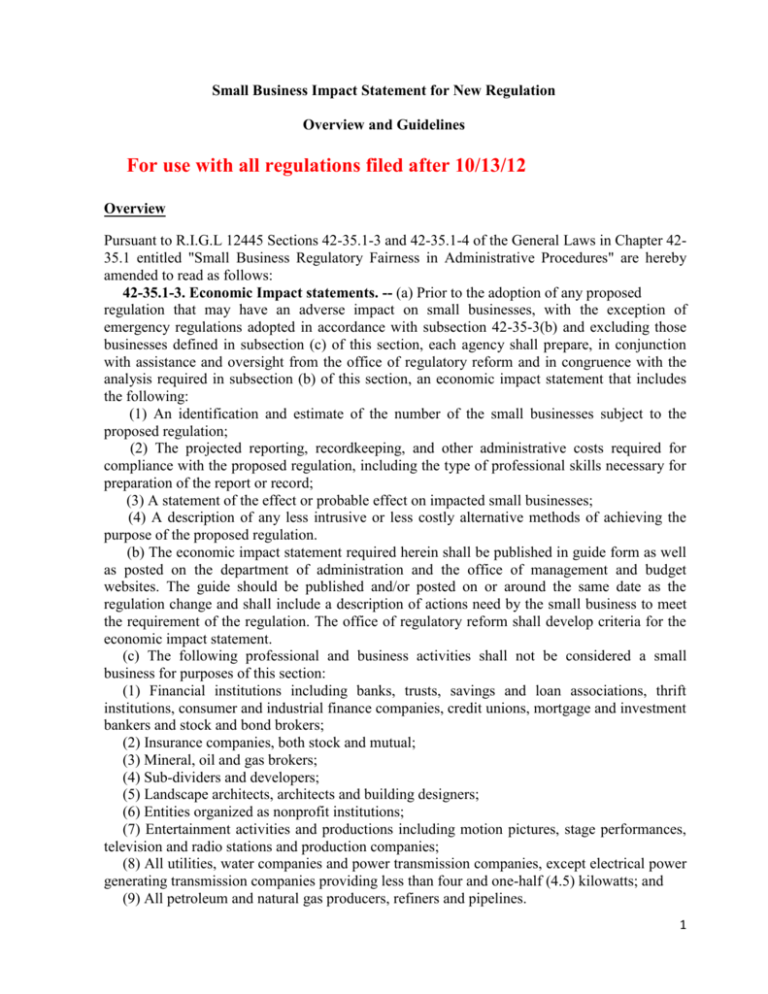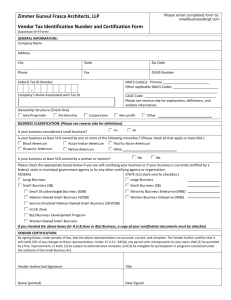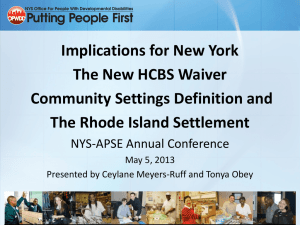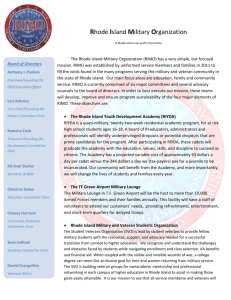New-Regulation-RI-Small-Business-Impact-Statement
advertisement

Small Business Impact Statement for New Regulation Overview and Guidelines For use with all regulations filed after 10/13/12 Overview Pursuant to R.I.G.L 12445 Sections 42-35.1-3 and 42-35.1-4 of the General Laws in Chapter 4235.1 entitled "Small Business Regulatory Fairness in Administrative Procedures" are hereby amended to read as follows: 42-35.1-3. Economic Impact statements. -- (a) Prior to the adoption of any proposed regulation that may have an adverse impact on small businesses, with the exception of emergency regulations adopted in accordance with subsection 42-35-3(b) and excluding those businesses defined in subsection (c) of this section, each agency shall prepare, in conjunction with assistance and oversight from the office of regulatory reform and in congruence with the analysis required in subsection (b) of this section, an economic impact statement that includes the following: (1) An identification and estimate of the number of the small businesses subject to the proposed regulation; (2) The projected reporting, recordkeeping, and other administrative costs required for compliance with the proposed regulation, including the type of professional skills necessary for preparation of the report or record; (3) A statement of the effect or probable effect on impacted small businesses; (4) A description of any less intrusive or less costly alternative methods of achieving the purpose of the proposed regulation. (b) The economic impact statement required herein shall be published in guide form as well as posted on the department of administration and the office of management and budget websites. The guide should be published and/or posted on or around the same date as the regulation change and shall include a description of actions need by the small business to meet the requirement of the regulation. The office of regulatory reform shall develop criteria for the economic impact statement. (c) The following professional and business activities shall not be considered a small business for purposes of this section: (1) Financial institutions including banks, trusts, savings and loan associations, thrift institutions, consumer and industrial finance companies, credit unions, mortgage and investment bankers and stock and bond brokers; (2) Insurance companies, both stock and mutual; (3) Mineral, oil and gas brokers; (4) Sub-dividers and developers; (5) Landscape architects, architects and building designers; (6) Entities organized as nonprofit institutions; (7) Entertainment activities and productions including motion pictures, stage performances, television and radio stations and production companies; (8) All utilities, water companies and power transmission companies, except electrical power generating transmission companies providing less than four and one-half (4.5) kilowatts; and (9) All petroleum and natural gas producers, refiners and pipelines. 1 42-35.1-4. Regulatory flexibility -- Flexibility analysis required. -- (a) Notwithstanding any general or public law to the contrary, prior to the adoption of any proposed regulation on and after January 1, 2010, each agency shall prepare a regulatory flexibility analysis in which the agency shall, where consistent with health, safety, environmental, and economic welfare consider utilizing regulatory methods that will accomplish the objectives of applicable statutes while minimizing adverse impact on small businesses. The agency shall consider, without limitation, each of the following methods of reducing the impact of the proposed regulation on small businesses: (1) The establishment of less stringent compliance or reporting requirements for small businesses; (2) The establishment of less stringent schedules or deadlines for compliance or reporting requirements for small businesses; (3) The consolidation or simplification of compliance or reporting requirements for small businesses; (4) The establishment of performance standards for small businesses to replace design or operational standards required in the proposed regulation; and (5) The exemption of small businesses from all or any part of the requirements contained in the proposed regulation. (b) Prior to the adoption of any proposed regulation that may have an adverse impact on small businesses each agency shall notify the office of regulatory reform of its intent to adopt the proposed regulation. The office of regulatory reform shall advise and assist agencies in complying with the provisions of this section. A Snapshot of Small Businesses in Rhode Island Small businesses in Rhode Island account for a significant share of the state’s economic production and hiring. According to the Small Business Administration, as of 2008 there were 95,845 small businesses in Rhode Island. Of these, 24,824 were employers, accounting for 55.9% of private-sector jobs in the state.1 Given the important role small businesses play in the Rhode Island economy, it is critical that the effects a regulation has on small businesses be justified and mitigated to the greatest extent possible. Guidance for Determining How Many Small Businesses will be Impacted by the Proposed Regulation The U.S. Small Business Administration (SBA) defines small businesses according to size standards which are matched to the North American Industry Classification Systems (NAICS). The SBA table of small business size standards can be found at the following URL: 1 Small Business Administration Office of Advocacy, Small Business Profile: Rhode Islands, available online at: http://www.sba.gov/advocacy/848/12387. 2 http://www.sba.gov/content/table-small-business-size-standards. The SBA defines a small business differently depending on the industrial classification using either employee number or annual revenue. Because staff will most likely not have access to annual revenue data, small businesses should be considered to have an employee size of NO MORE THAN: 100 for Wholesale Trade (Sector 42); 200 for Retail Trade (Sector 44-45); and A small business is defined as one with fewer than 500 employees Step 1: Identify Business Sectors to be Impacted: Staff developing the regulation should generate a list of the business sectors (using the 6-digit NAICS codes) which their program thinks will be impacted by the regulation. o For the most current list of NAICS codes with definitions: http://www.census.gov/eos/www/naics/2007NAICS/2007_Definition_File.pdf Step 2: Determine the Number of Small Businesses in Each Sector: Once there is a list of 6-digit NAICS codes that are expected to be impacted by the regulation, determine the number of small businesses in Rhode Island with those NAICS codes by going to the SBA’s online searchable database of self-certified small businesses: http://dsbs.sba.gov/dsbs/search/dsp_dsbs.cfm Once at the SBA “Dynamic Small Business Search” page: i) In the first section (“Location of Firm”), scroll down to highlight Rhode Island. (Leave all other selections [congressional district, county, etc.] blank.) ii) Leave the “Government Certifications” selections as “Not Required” (this should be the default setting). iii) Leave the “Ownership and Self-Certifications” selections blank. iv) In “Specific Nature of Business,” enter the 6-digit NAICS code(s) from step one above. v) Leave the next four sections blank (General Nature of Business; Profile Last Updated; Maximum Acceptable Bonding Levels; and Quality Assurance Standards). vi) In the “Size” section, select “No More Than” and enter 500 employees (leave “Annual Revenue” blank). vii) Do not make any entries under “Capabilities” or “Searching for a Specific Profile.” viii) Under “Search Results Display Options” select the number of results you want to be shown (e.g. 500), and leave the columns to be displayed and tabular format at the default setting. ix) At the bottom of the screen, click on “Search Using These Criteria.” x) The number of firms displayed in your results table is the number of small businesses to be impacted by this regulation for the NAICS codes selected. Note: In some cases, staff will already have a list of businesses in RI that are projected to be impacted because the industry is currently regulated by an existing regulatory program and the information is collected in an existing database. Staff should determine whether this method will yield a more accurate list of small businesses to be impacted as opposed to searching the SBA database by NAICS code. 3 4 SMALL BUSINESS IMPACT STATEMENT In order to accurately predict the impact the adoption, amendment, or repeal of a regulation will have on small businesses, the promulgating authority must conduct a thorough analysis that not only considers the potential effects of the action but also quantifies the costs, if any, associated with each. The questions below are designed to aid promulgating authorities in conducting their analysis. Agency Submitting Regulation: Rhode Island Department of Children, Youth and Families Subject Matter of Regulation: Child Day Care Center, School Age Child Day Care Program Child Day Care Center Regulations for Licensure ERLID No: Child Day Care Center, School Age Child Day Care Program, 1271 Child Day Care Center Regulations for Licensure, 1281 Statutory Authority: RHODE ISLAND GENERAL LAWS 42-72 CHAPTER 72.1 - Licensing and monitoring of child care providers and child-placing agencies. Other Agencies Affected: N/A Other Regulations That May Duplicate or Conflict with the Regulation: N/A Describe the Scope and Objectives of the Regulation: The primary purpose of licensing a child day care center is to safeguard the well-being of the children served. Granting a license means there is clear evidence that the building and grounds are safe; that staff are appropriately trained and responsible; and that the program reflects an understanding of the healthy growth and development of children. Further, the license is meant to be an assurance to parents and the community that the children are being cared for in a safe, healthy environment where appropriate activities, time schedules, food, materials, equipment and staff are consistently available and are used for encouraging and supporting the children's physical, social, emotional, and intellectual 5 growth. Licensing is a method of regulation designed to implement the state's obligation to the families whose children attend day care centers. A license is granted after a detailed evaluation of the facility and program has shown that conformity to the established regulations prevails. Business Industry (s) Affected by the Regulation: Early Care and Education Programs Types of Businesses Included in the Industry (s): Day Care Centers Total Number of Small Businesses Included in the Regulated Industry (s) Please see the attached guidance documents for assistance determining the total number of small businesses: Approximately 410 Number of Small Businesses Potentially Subject to the Proposed Regulation: Approximately 410 What is the cost to your agency of establishing and enforcing this regulation? $1,201,792 The licensing unit, responsible for enforcing these regulations, consistS of: 6 social caseworker’s; 2 licensing aides; 2 child development specialists; 1 chief casework supervisor. What would the consequences be if the regulation did not exist? The safety and well-being of thousands of Rhode Island children could be compromised. Effective Date Used In Cost Estimate: June 14, 2013 For each question below, please answer “yes” or “no” and offer a brief explanation. Please describe any facts, data, views, arguments, or other input from small businesses, organizations or any other sources that were used to quantify the impacts outlined below. 6 *The Day Care Regulations have been in existence for a number of years. However, this is the first time we have conducted the small business impact statement. As such, we have indicated impact on proposed changed to regulations along with impact on regulations as a whole. Yes No *Note: For each question, please answer “yes” or “no” and offer a brief explanation. Please describe any facts, data, views, arguments, or other input from small businesses, organizations or any other sources that were used to quantify the impacts outlined below. Yes No Will small businesses have to create, file, or issue additional reports? Yes No Will small businesses have to implement additional recordkeeping procedures? No new recordkeeping procedures based on proposed changes. However, day care centers are required to maintain records on staff, training and children served in accordance with the existing regulations. Yes No Will small businesses have to provide additional administrative oversight? The proposed regulations include a new requirement to develop and maintain an emergency plan. The programs previously had plans but they were not required in the regulations. The program director has always had responsibility to provide administrative oversight of the program as a whole. Yes No Will small businesses have to hire additional employees in order to comply with the proposed regulation? The proposed regulations do not require additional employees. The existing regulations have specific staffing requirements that depend on the size of the program and age of the children. Yes No Does compliance with the regulation require small businesses to hire other professionals (e.g. a lawyer, accountant, engineer, etc.)? Programs serving infants under the age of eighteen months are required to have a nurse on the premises a minimum of three hours per day. Yes No Does the regulation require small businesses to purchase a product or make any other capital investments in order to comply with the regulation? The proposed regulations require use of room dividers to separate groups of children. These dividers can be bookcases or other furniture and do not have to be walls. The existing regulations require cribs, beds, and other equipment depending on the size of the program, the number and ages of children served. The proposed regulations require appropriate playground equipment and cushioning materials for the playground. The facilty may have to make capital investments to their building for compliance if there are any issues with the quality of their drinking water, lead paint, radon or asbestos on the premises to which children may be exposed. Yes No Are performance standards more appropriate than design standards? There is no change to the existing regulations in this regard. The existing 7 regulations dictate staffing and programmatic requirements and physical plant requirements based on safety of children. Yes No Does the regulation require small businesses to cooperate with audits, inspections, or other regulatory enforcement activities? The proposed regulations include asbestos compliance which is a federal requirement. Day Care Centers must hire an inspector (approved by the Department of Health) to inspect initially for asbestos. If cleared initially, no further inspections for asbestos are required. If “asbestos safe”, annual inspections are required. Existing regulations require radon inspections (every 3 years), fire and lead inspections (every year), DCYF inspections (every 2 years). Yes No Will the regulation have the effect of creating additional taxes and/or fees for small businesses? The proposed regulations do not contact any new taxes or fees. The existing regulations require a $500/year licensure fee. Yes No Does the regulation require small businesses to provide educational services to keep up to date with regulatory requirements? The proposed regulations do not contain any new training/education requirements. The existing regulations require each employee to receive 20 hours of training per year. There may or may not be any cost associated with this training which can be in-house. Some Centers conduct training after hours which requires overtime pay. An estimate for a center’s annual training related costs might be $800 per year (depending on size of program and number of staff). Yes No Is the regulation likely to deter the formation of small businesses in Rhode Island? Yes No Is the regulation likely to encourage the formation of small businesses in Rhode Island? The proposed changes would not encourage or discourage formation of a small business. The existing regulations are reasonable and provide for the safety and well-being of children. Yes No Can the regulation provide for less stringent compliance or reporting requirements for small businesses? Yes No Can the regulation establish less stringent schedules or deadlines for compliance or reporting requirements for small businesses? Yes No Can the compliance or reporting requirements be consolidated or simplified for small businesses? Yes No Can performance standards for small businesses replace design or operational standards? Yes No Are there alternative regulatory methods that would minimize the adverse impact on small businesses? 8 Yes No Were any small businesses or small business organizations contacted during the preparation of this document? If so, please describe. The Department reviewed the budget/expenditure reports of two Day Care Centers to gain cost estimates. 9








